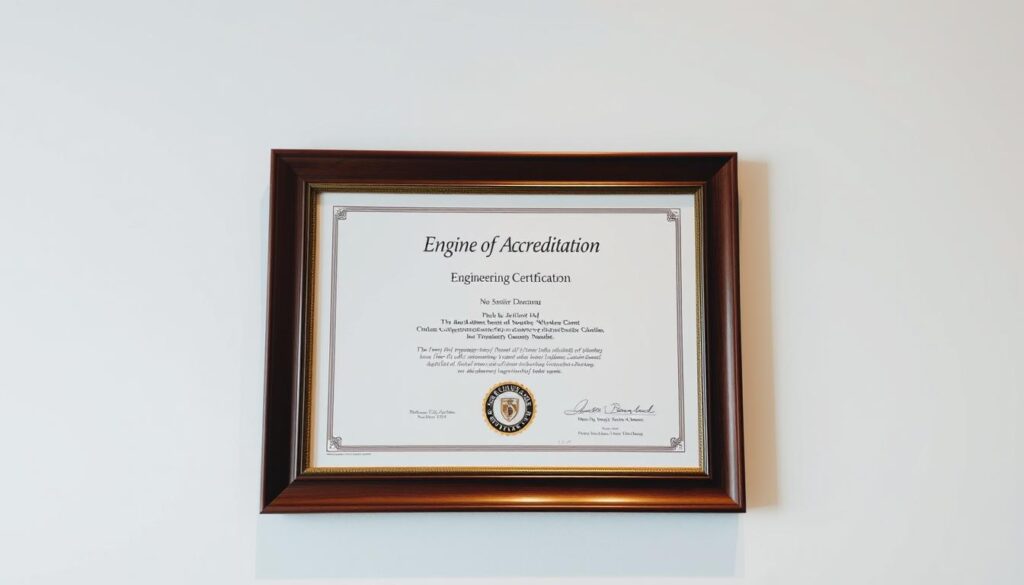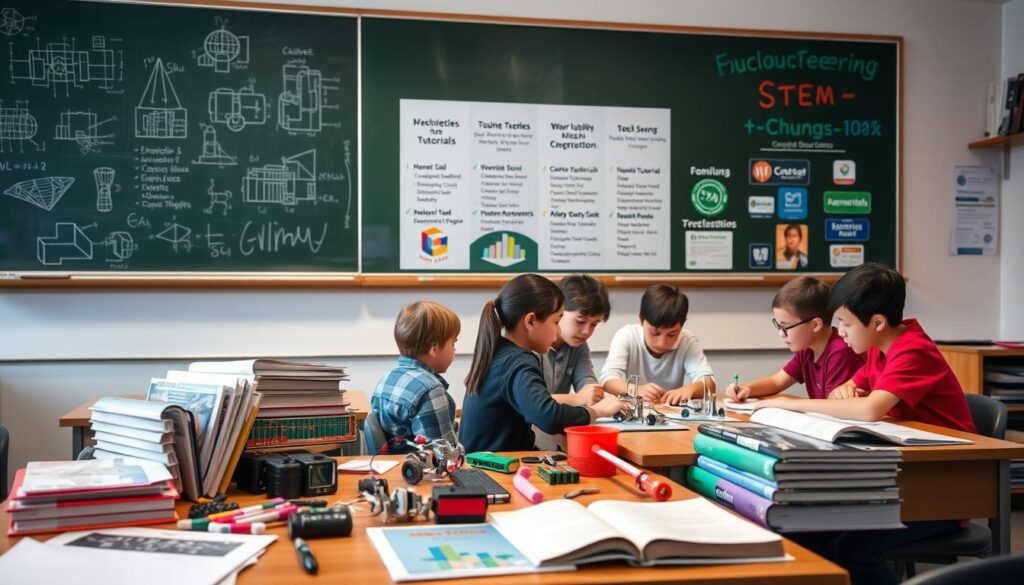Are you aware of the significant impact that STEM education has on shaping the future of our children?
The Next Generation Science Standards (NGSS) have revolutionized the way science is taught in the U.S., focusing on hands-on learning experiences that foster a deeper understanding of complex concepts.
By integrating engineering standards into the curriculum, educators can provide students with the skills and knowledge necessary to succeed in an increasingly complex and technological world.
Key Takeaways
- The NGSS has transformed STEM education across the U.S.
- Hands-on learning experiences foster a deeper understanding of complex concepts.
- Engineering standards play a crucial role in shaping STEM education.
- Resources for engineering education are available to support educators.
- The integration of engineering standards prepares students for future challenges.
Introduction to Schools Engineering Standards
Engineering standards in schools are not just guidelines; they are the backbone of a robust STEM education. As we continue to evolve in a technology-driven world, the need for a well-structured engineering curriculum has become increasingly important.
The Next Generation Science Standards (NGSS) framework has been instrumental in integrating science concepts and STEM subjects, thereby enhancing student understanding and skills. This integration is crucial for fostering a generation that is adept at solving complex problems through the application of scientific and engineering principles.
Importance of Engineering Standards in Education
Engineering standards play a vital role in education by providing a clear framework for what students should know and be able to do in various engineering disciplines. These standards are designed to ensure that students are well-prepared for the challenges of the 21st century.
“The incorporation of engineering standards into school curricula is a significant step towards creating a more cohesive and effective STEM education program.” –
The importance of engineering accreditation cannot be overstated, as it ensures that educational programs meet certain standards of quality. This, in turn, affects the employability and readiness of graduates in the engineering field.
Overview of Engineering Disciplines in Schools
Schools today offer a variety of engineering disciplines, ranging from mechanical and electrical engineering to civil and biomedical engineering. These disciplines are designed to cater to different interests and career aspirations, providing students with a broad spectrum of choices.
- Mechanical Engineering: Focuses on the design and development of mechanical systems.
- Electrical Engineering: Deals with the study and application of electrical systems.
- Civil Engineering: Concerned with the design, construction, and maintenance of infrastructure.
- Biomedical Engineering: Applies engineering principles to medical and biological systems.
These disciplines are guided by national curriculum guidelines that help in standardizing the education provided across different institutions. By adhering to these guidelines, schools can ensure that their engineering programs are comprehensive and relevant to current industry needs.
Historical Background of Engineering Standards
Understanding the historical context of engineering standards is crucial for appreciating the current state of STEM education. The development of these standards has been a long process, influenced by various factors including technological advancements and educational reforms.
The Next Generation Science Standards (NGSS) were developed in the early 2000s to transform K-12 science education, replacing outdated standards and emphasizing engineering practices and STEM education. This marked a significant shift towards integrating engineering into the curriculum.
Key Developments in Educational Engineering
Several key developments have shaped educational engineering over the years. These include the introduction of new technologies, changes in educational policies, and the growing recognition of the importance of STEM fields.
- Advancements in computer-aided design (CAD) software
- Increased focus on project-based learning
- Integration of engineering principles into K-12 education
Influence of Technology on Standards Evolution
Technology has played a pivotal role in the evolution of engineering standards. The rise of digital tools and online resources has enabled more effective teaching and learning of engineering concepts.

| Year | Development | Impact on Engineering Standards |
|---|---|---|
| Early 2000s | Introduction of NGSS | Emphasis on engineering practices and STEM |
| 2010s | Adoption of CAD software in schools | Enhanced design and problem-solving skills |
| Present | Integration of emerging technologies like AI and robotics | Preparation for future technological advancements |
Current Schools Engineering Standards
Understanding the current schools engineering standards is essential for educators, policymakers, and students alike. These standards form the backbone of engineering education, ensuring that students acquire the necessary skills and knowledge to succeed in their future careers.
The Next Generation Science Standards (NGSS) have been adopted by 20 states, with 24 other states using science education standards based on the NGSS framework. This widespread adoption underscores the importance of having robust and relevant engineering standards in schools.
Overview of Existing Standards
Existing engineering standards in schools focus on developing critical thinking, problem-solving, and collaboration skills among students. These standards are designed to be rigorous and relevant, preparing students for the challenges of the 21st century.
For instance, the NGSS emphasizes the integration of engineering practices with scientific knowledge to foster innovation and creativity. By doing so, students learn to approach problems from multiple angles and develop practical solutions.
Differences Between States in Engineering Standards
While there is a general framework guiding engineering standards, there are notable differences in how these standards are implemented across different states. Some states have adopted the NGSS in its entirety, while others have adapted it to fit their specific educational needs.
For example, states like California and Massachusetts have incorporated engineering principles into their K-12 curriculum, providing students with early exposure to engineering concepts. Other states, such as Texas, have developed their own standards that, while similar in scope, have distinct differences in emphasis and application.
To explore how different regions approach engineering education, it’s worth examining programs that attract international students. For more information on top civil engineering programs, visit top civil engineering programs for international.
The variation in engineering standards between states highlights the need for ongoing collaboration and sharing of best practices among educators and policymakers. By working together, they can ensure that engineering education remains relevant and effective across different regions.
Importance of Accreditation in Engineering Programs
As the demand for skilled engineers grows, the role of accreditation in shaping engineering programs becomes increasingly crucial. Accreditation is a process that ensures engineering programs meet specific standards, providing students with a quality education that prepares them for the workforce.
Accreditation bodies play a pivotal role in this process. Organizations such as the Accreditation Board for Engineering and Technology (ABET) in the United States are responsible for evaluating engineering programs against established criteria. These criteria include factors such as curriculum, faculty qualifications, and facilities.
Role of Accreditation Bodies
Accreditation bodies like ABET not only assess the quality of engineering programs but also provide guidance on how to improve. By setting rigorous standards, they help institutions maintain a high level of education, ensuring that graduates are well-prepared to enter the engineering profession.
The evaluation process involves a thorough review of the program’s curriculum, faculty expertise, and resources. This ensures that accredited programs are capable of delivering a comprehensive engineering education that aligns with industry needs.

Benefits of Accreditation for Schools
For schools, achieving accreditation for their engineering programs offers several benefits. It enhances the program’s reputation, making it more attractive to prospective students. Accreditation also facilitates the transfer of credits between institutions, providing greater flexibility for students.
Moreover, accredited programs are more likely to attract industry partners, leading to opportunities for collaborative research, internships, and job placements. This not only benefits the students but also contributes to the advancement of engineering knowledge and practice.
In conclusion, accreditation is essential for maintaining the quality and relevance of engineering programs. By understanding its importance and leveraging the benefits it provides, schools can better prepare their students for successful careers in engineering.
Curriculum Development in Engineering Education
Curriculum development in engineering education is guided by rigorous standards that ensure quality and relevance. These standards are crucial in shaping the educational content and ensuring it meets the needs of the industry and society.
How Standards Influence Curriculum
Engineering standards significantly influence the curriculum by outlining the necessary skills and knowledge that students should acquire. The Next Generation Science Standards (NGSS) framework, for example, emphasizes the integration of science concepts and STEM subjects, enhancing student understanding and skills. This integration is vital for preparing students to tackle complex engineering problems.
The curriculum is designed to be comprehensive, covering both theoretical foundations and practical applications. By adhering to established standards, educational institutions can ensure that their curriculum is relevant and effective.
Incorporating Real-World Applications
Incorporating real-world applications into the curriculum is essential for making learning relevant and engaging. By using real-world examples, educators can help students understand the practical implications of engineering concepts. This approach not only enhances student engagement but also better prepares them for the challenges they will face in their professional careers.
Project-based learning is one effective method for incorporating real-world applications into the curriculum. This approach involves students working on projects that require them to apply engineering principles to solve real-world problems.
By integrating real-world applications and adhering to national curriculum guidelines, engineering programs can provide students with a comprehensive education that prepares them for success in their chosen field.
Assessment and Evaluation Methods
Assessment and evaluation are crucial components of engineering education, ensuring students meet the required schools engineering standards. These processes not only measure student understanding but also inform instruction and improve program effectiveness.
The Next Generation Science Standards (NGSS) focus on student performance, with performance expectations that include disciplinary core ideas, science and engineering practices, and crosscutting concepts. This framework emphasizes the importance of assessing student learning in a comprehensive manner.
Types of Assessment Used in Engineering Programs
Engineering programs utilize a variety of assessment types to evaluate student learning. These include:
- Formative assessments, which monitor student progress and inform instruction
- Summative assessments, which evaluate student learning at the end of a lesson or course
- Project-based assessments, which require students to apply engineering concepts to real-world problems

Importance of Continuous Evaluation
Continuous evaluation is essential in engineering education, as it allows programs to adapt to changing engineering accreditation requirements and industry needs. By regularly assessing student learning and program effectiveness, institutions can identify areas for improvement and make data-driven decisions.
The benefits of continuous evaluation include:
- Improved student outcomes through targeted interventions
- Enhanced program reputation through accreditation and industry recognition
- Increased faculty engagement in curriculum development and assessment
By implementing robust assessment and evaluation methods, engineering programs can ensure that students are well-prepared for careers in the field and that programs meet the required schools engineering standards.
Teaching Methods in Engineering Education
The integration of hands-on learning experiences is transforming the way engineering is taught. This approach not only enhances student engagement but also prepares them for the practical challenges of their future careers.
Innovative Approaches to Teaching Engineering
Innovative teaching methods are crucial for the success of engineering students. One such approach is the use of project-based learning, where students work on real-world projects that require the application of theoretical knowledge. This method is particularly effective in STEM education as it encourages problem-solving and collaboration.
“The Next Generation Science Standards (NGSS) framework emphasizes the importance of hands-on learning and the integration of science concepts and STEM subjects.”
Another innovative approach is the flipped classroom model, where lectures are delivered online, and class time is used for interactive activities and discussions. This approach allows for more personalized instruction and enhances student understanding.
Engaging Students Through Hands-On Learning
Hands-on learning is a key component of effective engineering education. By engaging in experiments, projects, and other practical activities, students gain a deeper understanding of engineering principles. For instance, students can participate in robotics competitions or work on projects that involve designing and building prototypes.
For more information on how to unlock engineering careers, visit this resource.
| Teaching Method | Description | Benefits |
|---|---|---|
| Project-Based Learning | Students work on real-world projects | Enhances problem-solving, collaboration |
| Flipped Classroom | Lectures delivered online, class time for interactive activities | Personalized instruction, enhanced understanding |
| Hands-On Learning | Practical activities, experiments, projects | Deeper understanding of engineering principles |
In conclusion, the use of innovative teaching methods and hands-on learning experiences is crucial for the success of engineering students. By adopting these approaches, educators can provide students with the skills and knowledge needed to excel in their future careers.
Collaboration Between Schools and Industry
The integration of industry expertise into school curriculums is revolutionizing engineering education. By collaborating with industries, schools can provide students with real-world applications of engineering principles, enhancing their learning experience.
Benefits of Industry Partnerships
Industry partnerships offer numerous benefits, including access to cutting-edge technology, expert guest lectures, and internship opportunities. These collaborations can also lead to the development of curriculum that is more aligned with current industry needs.
Enhanced Learning Experience: Students gain from exposure to real-world projects and challenges, making their education more relevant and engaging. Moreover, industry partnerships can facilitate mentorship programs, where professionals guide students through their projects.
Examples of Successful Collaborations
Several institutions have successfully collaborated with industries to enhance their engineering programs. For instance, MIT’s Industrial Liaison Program brings together academia and industry to drive innovation. Similarly, Stanford University’s Industry-University Cooperative Research Program fosters collaborative research between academia and industry.
These collaborations not only benefit students but also contribute to the advancement of engineering fields by addressing real-world challenges. 
Furthermore, industry partnerships can lead to sponsored research projects, providing students with hands-on experience in solving complex engineering problems. This synergy between schools and industry is crucial for the development of future engineers who are well-equipped to tackle the challenges of their profession.
Challenges Faced in Implementing Standards
Engineering standards are crucial in STEM education, but their implementation can be fraught with difficulties. Schools across the United States face various challenges when trying to integrate these standards into their curricula.
Common Hurdles in Schools
One of the primary obstacles is the lack of resources, including inadequate funding and insufficient infrastructure to support modern engineering education. Additionally, there is often a shortage of qualified teachers who are trained in the latest engineering practices and technologies.
Another significant hurdle is the resistance to change within educational institutions. Implementing new standards requires a shift in teaching methodologies and assessment techniques, which can be met with skepticism by some educators.
Strategies to Overcome Implementation Barriers
To overcome these challenges, schools can adopt several strategies. Professional development programs for teachers are essential to equip them with the necessary skills and knowledge to effectively teach engineering standards.
Collaboration with industry partners can also provide valuable resources and insights, helping schools to stay updated with the latest technologies and practices. Furthermore, allocating sufficient resources and budget for engineering programs is critical for successful implementation.
By understanding the common hurdles and implementing effective strategies, schools can successfully integrate engineering standards into their curricula, enhancing STEM education for their students.
Future Trends in Schools Engineering Standards
Future trends in schools engineering standards are being shaped by innovative technologies and evolving educational needs. As we move forward, it’s essential to understand how these trends will impact engineering education.

Impact of Emerging Technologies
Emerging technologies such as Artificial Intelligence (AI), Internet of Things (IoT), and Virtual Reality (VR) are transforming the landscape of engineering education. These technologies are not only changing the way engineers work but also how they are educated. For instance, AI can personalize learning experiences, while VR can provide immersive, hands-on training.
According to a report by the National Science Foundation, integrating emerging technologies into K-12 education can significantly enhance student engagement and understanding of complex engineering concepts (NSF Report on Engineering in K-12).
Predictions for Next Decade in Engineering Education
Looking ahead to the next decade, several trends are expected to shape engineering education. One key prediction is the increased demand for engineers with expertise in sustainable technologies and renewable energy systems. As highlighted by World Civil Society, the need for engineers who can develop sustainable solutions will be crucial in addressing global challenges (Engineers in Demand by 2030).
Key trends include:
- Increased focus on sustainability and environmental engineering
- Integration of AI and machine learning in engineering curricula
- Greater emphasis on interdisciplinary collaboration and communication skills
- Expansion of online and hybrid learning models
These trends underscore the need for engineering program certifications that validate the quality and relevance of engineering education. By adapting to these trends, educational institutions can ensure that their graduates are well-prepared to meet the challenges of the future.
Role of Teachers in Meeting Engineering Standards
Effective implementation of engineering standards in schools relies heavily on the competence and collaboration of teachers. Teachers are at the forefront of educational delivery, and their ability to integrate engineering standards into their curriculum is crucial for student success.
Professional Development for Educators
Professional development is essential for educators to stay updated on the latest STEM education trends and methodologies. This includes training on new technologies and teaching techniques that align with national curriculum guidelines.
- Workshops on innovative teaching methods
- Training sessions on integrating technology into the classroom
- Opportunities for collaboration with industry professionals
By enhancing their skills and knowledge, educators can more effectively teach engineering concepts and prepare students for future challenges.
Importance of Teacher Collaboration
Teacher collaboration is vital for creating a cohesive and comprehensive engineering education program. When teachers work together, they can share best practices, develop unified lesson plans, and support one another in implementing national curriculum guidelines.
Key benefits of teacher collaboration include:
- Improved consistency in teaching engineering standards
- Enhanced student understanding through coordinated efforts
- Increased innovation in curriculum development
By fostering a collaborative environment, schools can ensure that their engineering programs are robust, relevant, and aligned with both STEM education principles and national standards.
Resources for Educators and Students
Educators and students in the field of engineering can benefit from a variety of resources to support their learning and teaching endeavors. These resources can enhance the educational experience, providing valuable tools and information to improve understanding and skills in engineering.
Recommended Books and Online Resources
Several books and online resources are highly recommended for educators and students. For instance, Common Sense Education provides a list of top engineering resources for students, including interactive websites and educational software.
Some of the key online resources include:
- Interactive simulations and modeling tools
- Online courses and tutorials
- Engineering blogs and forums
These resources can be used to supplement traditional teaching methods, providing a more engaging and interactive learning experience. For example, interactive simulations can help students understand complex engineering concepts by visualizing them in a controlled environment.

Professional Organizations and Support Networks
In addition to online resources, professional organizations play a crucial role in supporting educators and students in the field of engineering. These organizations often provide accreditation, professional development opportunities, and networking events.
For example, becoming a chartered civil engineer involves meeting specific educational and professional standards, which can be facilitated through professional organizations.
Some of the benefits of joining professional organizations include:
- Access to industry events and conferences
- Opportunities for professional development and continuing education
- Networking opportunities with other professionals in the field
As noted by a prominent figure in engineering education, “Professional organizations are essential for staying current with industry developments and best practices in engineering education.”
“The future of engineering education depends on our ability to adapt to changing technologies and industry needs.”
By leveraging these resources, educators and students can work together to advance the field of engineering and meet the challenges of the future.
Conclusion: The Path Forward for Schools Engineering Standards
As we look to the future of engineering education, it’s clear that STEM education plays a vital role in shaping the next generation of innovators and problem-solvers. The implementation of national curriculum guidelines has been a significant step forward, but there is still much work to be done.
Enhancing Engineering Education
The Next Generation Science Standards (NGSS) have the potential to significantly enhance engineering education by providing a framework for rigorous and relevant learning experiences. To fully realize this potential, continued support and collaboration among educators, policymakers, and industry stakeholders are necessary.
Moving Forward Together
By working together, we can ensure that engineering education remains a priority and that students are equipped with the skills and knowledge needed to succeed in an increasingly complex and technological world. This collaborative effort will be crucial in driving progress and innovation in STEM education.
